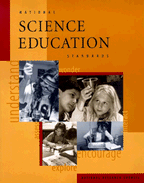 |
|||||
| Home | Research | For Teachers | HISTORY Level 1 Level 2 Level 3 |
PRINCIPLES Level 1 Level 2 Level 3 |
CAREER Level 1 Level 2 Level 3 |
| Gallery | Hot Links | What's New! | |||
| Web Administration and Tools | |||||
 |
|||||
| Home | Research | For Teachers | HISTORY Level 1 Level 2 Level 3 |
PRINCIPLES Level 1 Level 2 Level 3 |
CAREER Level 1 Level 2 Level 3 |
| Gallery | Hot Links | What's New! | |||
| Web Administration and Tools | |||||

The National Science Education Standards are the efforts of many well respected educators around our nation. The project was approved by the Governing Board of the National Research Council. The work encompasses among other things, a change in emphases in how science is usually taught. We at ALLSTAR wish to thank the National Academy Press for allowing us to directly use the materials from the National Science Education Standards. It is our belief that if you are involved in teaching science, evaluating science programs, or intend to use the national standards, it would be best for you to visit their web site to gain a better understanding of what the project is all about. For your convenience, we provided a hot link at the bottom of the page. We have highlighted only the content standards that apply to the ALLSTAR web site. To that end, the content standards that are not covered at ALLSTAR are intentionally left out, yet we kept the numbering scheme intact in order to maintain continuity in lesson planning. |
 |
Note: Whenever you see this picture, look for a quote of special interest from the National Academy Press, National Science Education Standards publication. © The NAP reserves all rights, and our use is with permission! |
| Science as Inquiry |
CONTENT STANDARD A:
As a result of activities in grades K-4, all students should develop:
| Abilities necessary to do scientific inquiry | |
| Understandings about scientific inquiry |
For samples of an ALLSTAR lesson for this standard, click on the word "Example" or highlighted word(s) in the text.
Fundamental abilities and concepts that underlie this standard include:
| ABILITIES NECESSARY TO DO SCIENTIFIC INQUIRY | ||
| ASK A QUESTION ABOUT OBJECTS, ORGANISMS, AND EVENTS IN THE ENVIRONMENT | Example 1 | |
| PLAN AND CONDUCT A SIMPLE INVESTIGATION. | Example 1 | |
| EMPLOY SIMPLE EQUIPMENT AND TOOLS TO GATHER DATA AND EXTEND THE SENSES. | Example 1 | |
| USE DATA TO CONSTRUCT A REASONABLE EXPLANATION. | Example 1 | |
| COMMUNICATE INVESTIGATIONS AND EXPLANATIONS. |
 |
"Students should begin developing the abilities to communicate, critique, and analyze their work and the work of other students. This communication might be spoken or drawn as well as written". |
CONTENT STANDARD B:
As a result of the activities in grades K-4, all students should develop an understanding of:
| Properties of objects and materials |
| Position and motion of objects |
| Light, heat, electricity, and magnetism |
For samples of an ALLSTAR lesson for this standard, click on the word "Example" or highlighted word(s) in the text.
Fundamental concepts and principles that underlie this standard include:
PROPERTIES OF OBJECTS AND MATERIALS
| Other examples for Properties of Objects and Materials | Example 1 |
POSITION AND MOTION OF OBJECTS
| Examples for Position and Motion of Objects | N/A |
LIGHT, HEAT, ELECTRICITY, AND MAGNETISM
| Examples for Light, Heat, Electricity, and Magnetism | Example 1! |
 |
" ...By grade 4, distinctions between the properties of objects and materials can be understood in specific contexts, such as a set of rocks or living materials." |
As a result of activities in grades K-4, all students should develop:
| Abilities of technological design |
| Understandings about science and technology |
| Abilities to distinguish between natural objects and objects made by man |
Fundamental abilities and concepts that underlie this standard include:
ABILITIES OF TECHNOLOGICAL DESIGN
| Examples for Abilities of technological design | Example 1 |
UNDERSTANDING ABOUT SCIENCE AND TECHNOLOGY
| Other examples for Understandings About Science and Technology | Example 1, Example 2 |
ABILITIES TO DISTINGUISH BETWEEN NATURAL OBJECTS AND OBJECTS MADE BY HUMANS
| Other examples in Abilities to Distinguish Between Natural Objects and Objects Made by Man | N/A |
![]() Science in Personal and Social
Perspectives
Science in Personal and Social
Perspectives
As a result of activities in grades K-4, all students should develop understanding of:
| Personal health | |
| Characteristics and changes in populations | |
| Types of resources | |
| Changes in environments | |
| Science and technology in local challenges |
For samples of an ALLSTAR lesson for this standard, click on the word "Example" or highlighted word(s) in the text.
| Personal health | N/A | |
| Characteristics and changes in populations | N/A | |
| Types of resources | N/A | |
| Changes in environments | N/A |
SCIENCE AND TECHNOLOGY IN LOCAL CHALLENGES
| Other examples for Science and Technology in Local Challenges | Example 1 |
As a result of activities in grades K-4, all students should develop understanding of:
| Science as a human endeavor |
Fundamental concepts and principles that underlie this standard include:
| Other examples for Science as a Human Endeavor | Example 1 |
 |
If you find this site useful in your classroom, please share this with us. |
Send all comments to ![]() aeromaster@eng.fiu.edu
aeromaster@eng.fiu.edu
© 1995-98 ALLSTAR Network. All rights reserved worldwide.
| Funded in part by | Under National Science Education Standards |
Updated: February 23, 1999